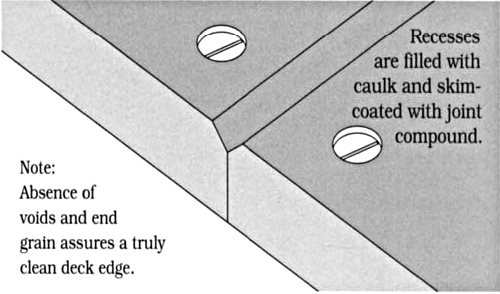Using Medium-Density Fiberboard as a Deck Lid |
Eric Weston |
Over the long term, the most cost-effective decks may be those made of stock platforms covered with a thin show skin of Masonite® or medium density fiberboard (MDF). Each time a stock platform is re-used, its effective cost decreases: and though the show skins themselves are less likely to be useful as stock, whole sheets and larger scraps can often be used in two productions at least, as long as both faces of the material are equally “good.”
On the other hand, the initial cost of such platforming is relatively high, since each platform has to be covered twice — once with a lid and once with a show skin. In an attempt to reduce the material and labor costs of the four, large throw-away decks we had to build for Arizona State University’s Crow and Weasel, I decided to test whether a single layer of deck surface material could work in place of the usual plywood lid and MDF skin combination. Because these four decks needed to look especially clean and seamless, ¾″-thick panels of MDF seemed the best possible choice.
DECK FRAMING
Since we weren’t building individual platforms, we butt-welded the 1½″ square tube steel we used as framing material into a single frame. We spaced the steel to accommodate the actual 49″ × 97″ size of the MDF we had bought, and included diagonal members to keep the frame in true. Legs of 1½″ square tube steel supported the horizontal framing members at nominal 4-foot o.c. increments. A view of a partly assembled deck appears in Figure 1.

FIGURE 1: CROW AND WEASEL THROW-AWAY DECK CONSTRUCTION
THE LID
Before fastening the panels to the frame, we chamfered the edges of each panel at 45° as in Figure 2. We then tek-screwed the MDF panels directly to the frame, butting the panels tight against each other and spacing the screws about 1′–0″ apart. Around the panels’ perimeters, we drilled and countersank pilot holes so that the edges wouldn’t break or chip, but we let all the other screws pilot and countersink themselves. Before painting the deck, we filled the screw heads and the seams between panels with latex caulk, which we smoothed with a putty knife.

FIGURE 2: LID COUNTERSUNK & CHAMFERED
For durability’s sake, we skim-coated the caulk with joint compound, which we sanded to efface any hint of seams. Paint and a satin clear-coat sealer finished the surface treatment.
EVALUATION
No doubt, MDF is not a perfect deck lid material. Among its limitations …
Though it obviously does have some structural value, MDF has no structural rating. Using the material as a deck lid requires an especially careful and conservative load analysis.
MDF is denser and heavier than plywood. Weighing about 96#, a ¾″-thick sheet is too heavy for use as a stock-platform lid.
MDF panels are larger than most other sheet goods. Standard panels are nominally 49″ × 97″. but their actual dimensions (including thickness) vary from one manufacturer to the next and even from lot to lot. Prudent users will buy all the MDF needed for a project at one time before detailing or laying out any framing.
The edges of MDF panels are straight and true enough for theatrical production, but the corners are not necessarily square.
Cutting or machining standard-grade MDF releases comparatively high levels of formaldehyde.
Standard-grade MDF reacts to wide changes in humidity, and may not be suitable for use in non-air-conditioned theaters in places less dry than Arizona.
Moreover, if I were to rebuild these four decks, I would reinforce the connection between lid and frame with a bead of construction adhesive. Under moderate traffic, the tek-screws loosen after a time, and the decks became somewhat noisy.
Nevertheless, given our original objectives, MDF was perhaps the best choice for these particular decks’ lids. After all, the decks’ edges presented no end grain or voids to be dressed. Our seam treatment made the joints nearly invisible, and the super-smooth and hard painted finish was exactly what we wanted. Finally, the price was right: we purchased ¾″ MDF at less than $21.00 a sheet — about what we pay for cdx plywood — and since we gave each deck only one cover, we saved a fair amount of our typical labor and materials costs.
